There is a common misconception that the sun’s rays reach the earth instantaneously. However, this is not the case. It is intriguing to explore the calculation of the time it takes for light to travel from the sun to the earth, as well as the reasons why this duration varies throughout the year. These facts are not only fascinating for children, but also for adults.
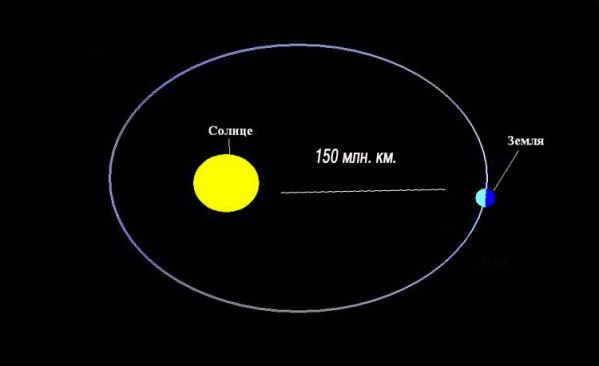
The Process of Sunlight Production
The warmth and light that the Sun emits, which sustains all life on our planet, is the outcome of intricate chemical reactions. The Sun, an immense luminous sphere of heat, consists of numerous layers of hydrogen and helium, spanning hundreds of thousands of kilometers. The temperature at the star’s surface measures 6000 Kelvin or 5726.85°C. However, at the core, where sunlight originates, this value significantly increases, reaching 15 million °K.
At this particular temperature and pressure, the fusion reaction of thermonuclear inside the core happens constantly: four hydrogen atoms combine to form a helium nucleus. This process repeats infinitely. In just one second, as a result of this fusion, 600 million tons of hydrogen are converted into helium. And every 70,000 years, the Sun transforms hydrogen in an amount equivalent to the mass of the Earth.
As a consequence of thermonuclear fusion, a significant amount of energy is released in the form of photons – weightless particles that exist solely by traveling at the speed of light. Throughout its lifespan, a photon is emitted and absorbed millions of times by gas molecules.
Fascinating fact: it would take a photon 200,000 years to travel from the core of the Sun to its surface.
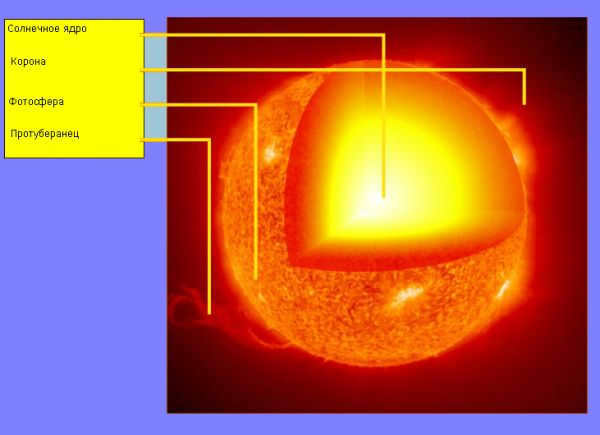
The structure of the Sun. It takes approximately 200,000 years for a photon to travel from the core to the surface. Source: 100-000-pochemu.info.
How much time does it take for light to travel from the Sun to the Earth?
In order to determine the duration of time it takes for a beam of light to reach the Earth, one must have knowledge of the distance between our planet and the Sun, as well as the speed at which light travels. The first attempts to calculate this distance, which countless photons traverse on a daily basis, were made in the late 17th century. Scientists of that era arrived at a value of 139 million kilometers, although it was not entirely accurate.
Subsequent calculations provided more accurate results, revealing that the distance between the Sun and the Earth is approximately 150 million kilometers. While this value is often treated as a constant known as an astronomical unit, it is important to note that our planet follows an elongated elliptical orbit, causing the distance between these celestial bodies to vary. In January, the distance decreases to around 147 million km (perihelion), while in July, it reaches its maximum at approximately 152 million km (aphelion).
In 1975, scientists determined the precise speed of photons in a vacuum to be 299,792,458 m/s. However, for most calculations, an approximate value of 300 thousand km/s is commonly used.
The table below provides the time it takes for solar rays to travel the distance to the Earth at different points along our planet’s orbit:
| Time taken for light to reach the Earth | ||
| min. | sec. | |
| for one astronomical unit | 8 | 17 |
| for perihelion | 8 | 3 |
| at aphelion | 8 | 25 |
Therefore, regardless of the time of year, it takes approximately 8 minutes and 3-25 seconds for sunlight to reach the Earth. If the Sun were to suddenly disappear, people on Earth would notice after the specified amount of time.
Interesting fact: solar radiation has the ability to penetrate deep into the ocean, reaching depths of up to 85 meters. It can also be slowed down or refracted when passing through different substances, ultimately focusing at a single point.
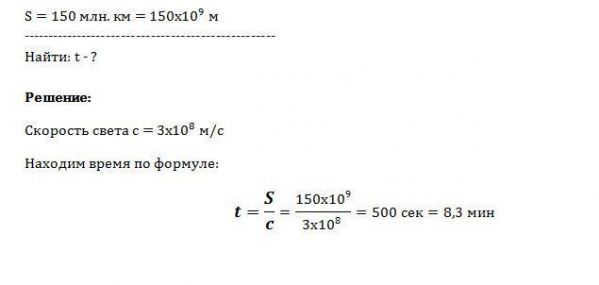
How much time does it take for light to reach Earth from other celestial objects?
In order to calculate the distance between various objects in space, astronomy utilizes a unit known as a light year. This measurement represents the distance that light travels through the vacuum of outer space in the span of one Earth year. In numerical terms, a light year is equivalent to 9,460,730,472,580,800 meters or over 63 thousand astronomical units.
The amount of time it takes for photons of light from the Sun to reach different objects in the universe is as follows:
- For the most distant planet from the Sun, Pluto, it takes approximately 5 hours for photons to travel.
- For the farthest point within our solar system, the Oort cloud composed of asteroids and debris, it takes a staggering 1.5 years for photons to reach.
- For the nearest bright star to Earth, Proxima Centauri, it takes approximately four years for photons to reach.
The time it takes for light to travel between the Moon and Earth is approximately 1.2 seconds, and radio waves also travel at this speed. This poses challenges when it comes to controlling spacecraft, such as the “Lunokhod”, as the signals experience a delay.
Instantaneous propagation of light does not occur. This is why many space phenomena can only be observed with a significant time delay. For instance, the bright star Polaris is situated around 400 light years away from Earth. The light we see from it today was actually emitted during the time of Columbus.
Space is so incredibly vast that it is nearly impossible for humans to comprehend its magnitude. Using ordinary tools for estimating distance is even more challenging. To tackle this issue, scientists developed a special unit of measurement known as the light year.
Understanding the Light Year
The light year is a significant unit of measurement used in astronomy and other space-related sciences. However, it is not suitable for measuring distances on Earth.
For example, if we were to apply this unit of measurement to the distance between Earth and the Moon, it would only amount to 1.25 seconds. Similarly, if we were to measure the distance between our planet and the Sun using light years, it would only be 8 minutes. This is because light from the Sun takes approximately 8 minutes to reach Earth.
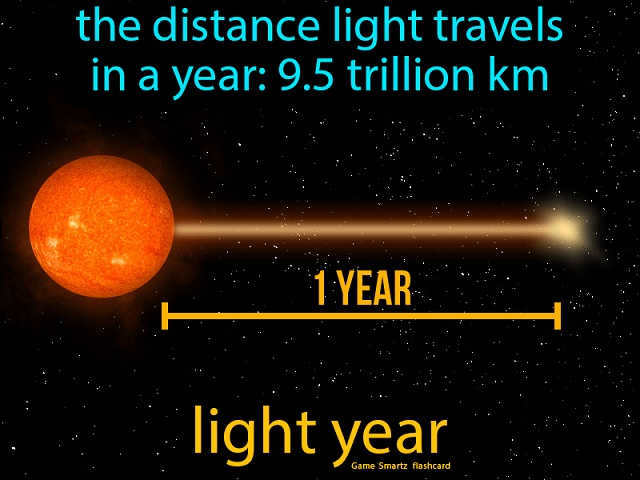
How can we comprehend the concept of a light year and the reasons behind the development of such a unique system of measurement? Let’s illustrate it with an example. Let’s say there’s an individual who travels from point A to point B and it takes them an hour to complete the journey. The distance between these two points is 3 km, and they maintain a constant speed of 3 km/h. In this hypothetical scenario, we could refer to this distance, from point A to point B, as a “human hour”.
Naturally, in reality, humans don’t walk at a constant speed and such large-scale units of space measurement are unnecessary in the context of our planet.
According to the concepts of modern scientists, when a beam of light is present in the empty vacuum of space, it maintains a constant speed that remains unchanged regardless of any external factors. This consistency allows scientists to accurately measure the distance that the beam has traveled. They achieve this by analyzing the time it takes for the beam to traverse a certain path.
Consequently, the quantity of space that the beam covers within a span of one minute is referred to as a “light minute”. Similarly, the distance that light can traverse within a year is known as a “light-year”. This system of measurement is crucial for evaluating the vast distances that separate celestial objects within the cosmos.
When employing this unit of measurement, scientists consider a year to consist of 365 and a quarter days, disregarding leap years.
The velocity of light
While formulating his theory of relativity, Albert Einstein demonstrated that light, when in a vacuum, consistently travels at a constant velocity. The location in which this occurs does not affect the velocity in any way. As a result, it is always possible to accurately determine the distance it will cover within a specific timeframe.
The velocity of light is a fixed and precisely established value. It is equivalent to 299,797,924.58 meters per second, 1,079,252,848.8 kilometers per hour, or 299,792.458 kilometers per second. In other words, within one second, the light beam always traverses 299,792,458 meters regardless of the circumstances.
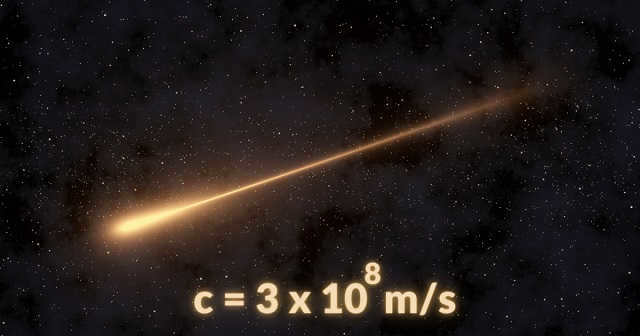
Determining the Speed of Light
How did scientists arrive at the precise value for the speed of light? The initial attempt to do so was undertaken by Danish astronomer Olaf Remer in 1676.
In order to compute this value, Remer utilized his measurements of the distance between Earth and the farthest known planet at that time, Jupiter. His findings yielded a speed of 214,000 km/s.
The significant disparity with the current accepted value can be attributed to the inaccuracies inherent in 17th century measurements.
James Bradley achieved the remarkable feat of approximating the value of the speed of light in 1728 by observing the Sun’s position relative to Earth. According to his observations, the speed of light was determined to be 301,000 km/s.
Léon Foucault further refined this measurement, determining the speed of light to be 298,000 km/s.
In 1983, scientists officially established and adopted the speed of light as the fundamental unit for their calculations in the modern world.
Reasons for using light-years
Why do scientists use light-years as a unit of measurement instead of more familiar distance units? The reason is that when it comes to measuring distances in space, using simple, Earth-based units is not suitable.
For example, Proxima Centauri, the closest star to our solar system, is located 4.2 light-years away. However, there are other stars that are visible to the naked eye without the aid of astronomical instruments, and they are much further away – some are hundreds, thousands, and even tens of thousands of light-years away.
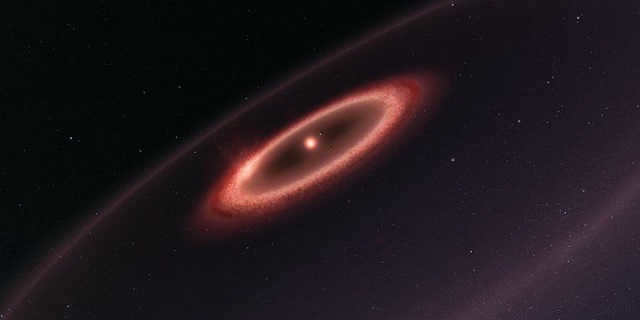
So, this unit of measurement is utilized to gauge the magnitude of space from one celestial body to another.
How many kilometers are in 1 light-year
How many kilometers does 1 light-year equal in terms of the distance traveled by Earth? To answer this query, we must first establish the exact number of hours in one year as we know it – 365.25 days. This equates to 8766 hours.
Now, all that remains is to multiply 8766 hours by the well-known speed at which light travels in 1 hour. By performing simple calculations, we arrive at a value of 9.46 trillion kilometers.
How many Earth years are in a light year
Sometimes individuals who are not well-versed in astronomy and physics often inquire about the conversion rate between light years and Earth years. Unfortunately, this question lacks a definitive answer due to the fact that these units of measurement serve different purposes.
A light year is a unit used to measure distance, whereas an Earth year is a measurement of time. Therefore, it is not possible to provide a direct correlation between the two.
Light speed calculator
How can you calculate the speed of light? You can do this by using a simple calculator. Just use the following formula:
What do all the numbers in this formula represent?
- 299,792,458 is the number of meters that light travels in one second;
- the first 60 represents the number of seconds in a minute;
- the second 60 represents the number of minutes in an hour;
- 24 represents the number of hours in a day;
- 365.25 represents the number of days in a year.
By using this calculator and substituting the desired number of days, it becomes possible to determine the distance between cosmic objects.
Other options instead of light years

In fields like physics and astronomy, different units are utilized to measure and assess vast spaces. The reason is that space is immense, and numerous intervals between celestial objects are too vast to be measured solely by the time taken for light to travel. This is where parsecs come into play. A parsec is approximately equivalent to 3.26 light-years or 30.857 trillion kilometers.
Astronomy also employs other units for measuring space. For instance, the astronomical unit and lunar distance are utilized. Lunar distance represents the approximate space between our planet and its natural satellite, the Moon. It is equivalent to 400,000 kilometers. Typically, it is employed when measuring the distance between Earth and an approaching object.
Distances measured in light-years
Here are some examples of distances measured in light-years:
- The distance between the Earth and Pluto, which used to be considered the ninth planet in our solar system, is approximately 5-5.9 hours of light travel.
- The diameter of our galaxy, known as the Milky Way, is about 100 thousand years of light travel.
- It takes approximately 2.4-2.7 million years for light to travel from the Milky Way to the relatively nearby Andromeda galaxy.
- Light from the Milky Way takes about 3 billion years to reach the closest bright celestial bodies known as quasars.
- The distance from the Milky Way to the farthest observable edge of the Universe is estimated to be around 14 billion years of light travel.
What is the distance between the Sun and the Earth in light years?
The distance from the Sun, which is the central star of our solar system, to our home planet, or in simpler terms, the amount of time it takes for light to travel from the Sun to the Earth, is approximately 8 minutes or around 0.0000152 years.
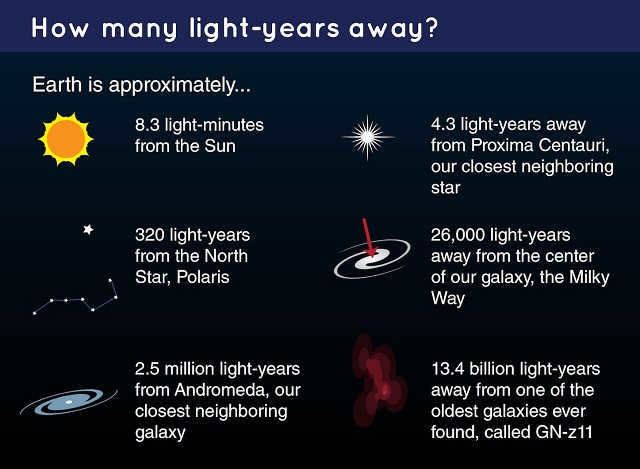
What is the distance from the Earth to the Moon in light years?
The distance from the Earth to its satellite, the Moon, can be measured in terms of time. It takes approximately 1.2-1.3 seconds for light to travel between the Earth and the Moon.
Some fascinating facts about light years
- Light years can also be measured in smaller units of time, such as hours, minutes, seconds, and even nanoseconds;
- The farthest distance ever traveled by a human-made object in space is 21.31 light-hours. This incredible feat was achieved by the Voyager 1 space probe;
- The closest dwarf galaxy to our Milky Way, known as the Big Dog, is located approximately 25,000 light years away;
- The farthest galaxy ever discovered is GN-z11, which is an astounding 13.4 billion light years away from our Earth.
- It serves as a means of gauging the vastness of the universe, enabling individuals to comprehend its sheer magnitude. Researchers employ this unit of measurement to approximate the distances between remote planets, stars, and galaxies in relation to our planet.
Video: the significance of the speed of light being 299,792,458 meters per second
It’s common knowledge that it takes a bit more than 8 minutes for a beam of light to travel from the Sun to the Earth. This fact is truly mind-blowing, as it means that if anything were to happen to our beloved star, we wouldn’t find out about it immediately, but rather with an 8-minute delay. However, the journey of this ray becomes even more awe-inspiring when you consider the time it takes for it to ascend from the Sun’s core to its surface.
Sunlight, as well as the sun itself, demands the utmost reverence. It is only thanks to the presence of an atmosphere and the perfect distance from the sun that the conditions for life are created. Merely approaching Venus or moving away from Mars can place one in a precarious state of extreme heat or freezing cold.
The sun can be likened to an onion in its structure, consisting of multiple layers. Each of these layers is a site of active nuclear and chemical reactions. Therefore, a minuscule photon must traverse a considerable distance in order to illuminate your morning.
Transitioning away from the center
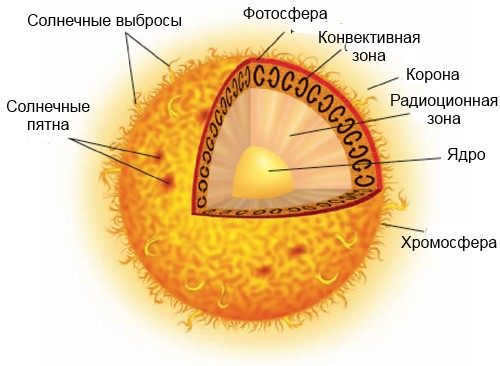

The structure within the Sun is fascinating. The radiation zone encompasses 0.25 to 0.7 of the solar radius. As we venture away from the core, the temperature gradually diminishes from 7 million K to 2 million K. The density, however, remains constant, ranging from 20 g/cm3 to 0.2 g/cm3.
At the heart of the Sun, which accounts for approximately 25% of its radius, the temperature soars beyond 15 million K. The immense gravitational force generates an intense pressure level, causing hydrogen atoms to fuse together in nuclear reactions.
Zone of Radiative Transfer
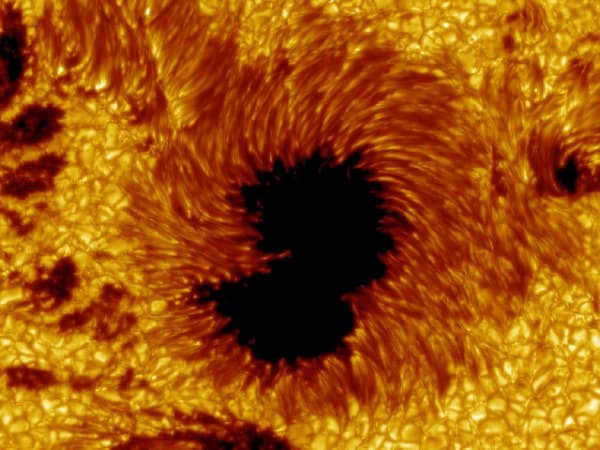
A detailed view of a sunspot
Located at 45% of the solar radius is the Radiative transfer zone. The density of matter in this region is so immense that it is converted into plasma. Photons obtain energy from the nucleus and travel a distance of 1 micron before being absorbed by the gas molecules. This triggers a chain reaction that slows down the entire process.
The gas molecule becomes hotter, emitting an additional photon with the same wavelength. This photon then travels another 1 micron before being absorbed by the gas molecule, causing it to heat up and continue the cycle. This is an extremely lengthy process that can last for millions of years millions of years. On average, it takes about 170,000 years for a photon to traverse this layer 170,000 years. Analysis indicates that the chain involves approximately 10.25 re-absorption-emission events.
We are currently in the convective zone.
Welcome to the outer layer of the solar system. I understand that the journey has been longer than anticipated, but it is not yet complete. You are observing a dynamic atmosphere characterized by convection currents that carry energy outward. These currents are responsible for lifting hot gas to the surface and causing cooler material from the photosphere to descend. In this region, photons travel at a faster pace. However, the entire journey from the core to the surface typically takes around 200,000 years (unless, of course, there are delays lasting a million years).
And so, after a 200,000-year voyage, the photon takes 8 minutes to fade away on the world, granting it with the eagerly awaited illumination. It is yet another justification to show greater reverence for solar phenomena.

Have you ever wondered why astronomers refrain from utilizing the light year as a measurement for calculating distances to remote celestial bodies?
The Light Year – Basic Facts
The light year is a unit of measurement that is commonly used in popular astronomy books and textbooks to describe distances in outer space. However, in the field of professional astrophysics, it is rarely used, particularly when calculating distances to objects that are not nearby. The main reason for this is that the distances to these objects would be so vast that using light years would be impractical and inconvenient for physical and mathematical calculations. Instead, professional astronomers use a different unit of measurement called parsec, which is more suitable for making complex mathematical calculations.
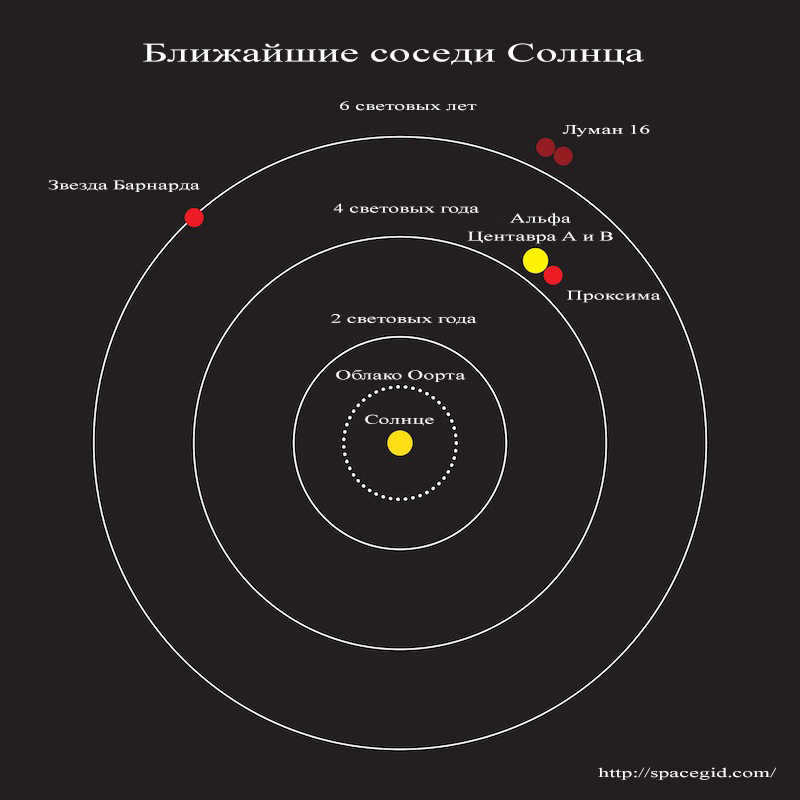
The nearest stars to the Sun
The term “light-year” can be found in any astronomy textbook. It is defined as the distance that a ray of light travels in one Earth year. While this definition may satisfy amateurs, experts in cosmology will find it lacking. They will point out that a light year is not just the distance that light travels in a year, but rather the distance that a beam of light travels in 365.25 Earth days in a vacuum, unaffected by magnetic fields.
A light year is equivalent to 9.46 trillion kilometers. This is the distance that a beam of light travels in one year. But how did astronomers arrive at such a precise definition of the path of light? We will discuss that below.
Discovering the Speed of Light: A Fascinating Journey
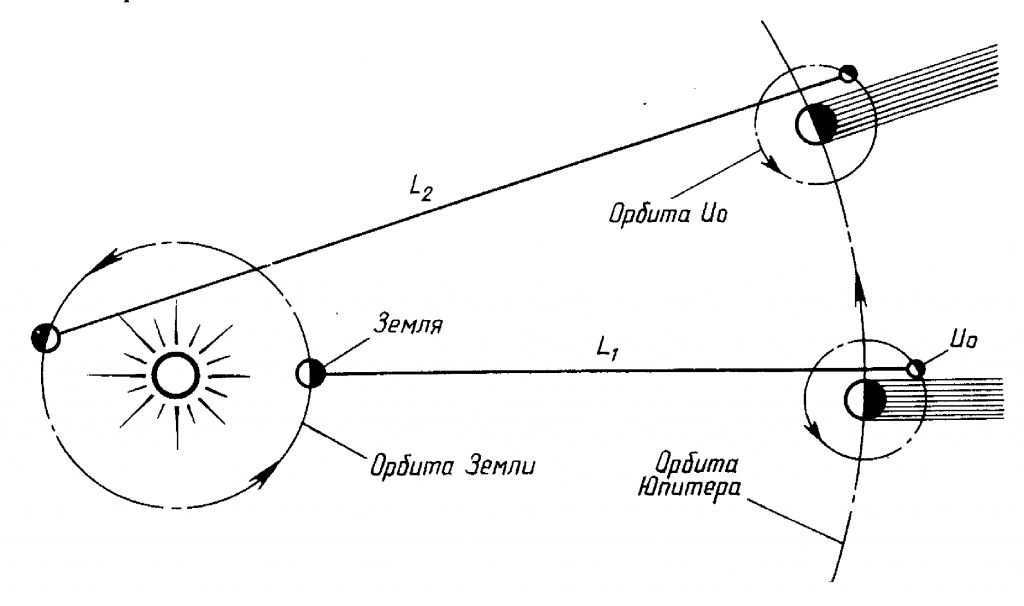
In ancient times, it was commonly believed that light propagated throughout the universe instantaneously. However, starting from the 17th century, scientists began to question this assumption. The first person to cast doubt on this prevailing belief was Galileo. He attempted to calculate the time it takes for a beam of light to travel a distance of 8 km. Unfortunately, the experiment proved unsuccessful as this distance was too insignificant in comparison to the speed of light.
The initial breakthrough in this matter came from the observations made by the renowned Danish astronomer Olaf Rømer. In 1676, Rømer noticed a discrepancy in the timing of Jupiter’s moon eclipses, depending on the Earth’s proximity to or distance from them in outer space. Rømer successfully linked this observation to the fact that as the Earth moves farther away from Jupiter, it takes longer for light reflected from the moons to reach our planet.
Rømer grasped the essence of this fact, but he was unable to accurately calculate the speed of light. His calculations were flawed because in the seventeenth century, he did not have precise data on the distances between the Earth and other planets in the solar system. These measurements were determined at a later time.
A hypothetical photon roaming between the Earth and the Moon. All ratios are accurate.
In 1728, the approximate speed of light was calculated by James Bradley, an astronomer from England who discovered the phenomenon of star aberration. He determined the speed to be 301,000 kilometers per second. However, this value turned out to be imprecise. More precise techniques for calculating the speed of light were developed without relying on celestial bodies – on the Earth.
Resources about the subject
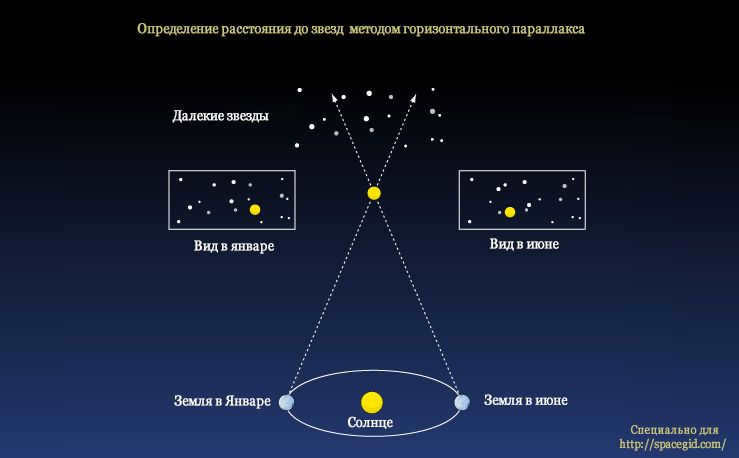
The measurement of the speed of light in a vacuum was conducted using a rotating wheel and a mirror by A. Fizeau and L. Foucault. Their observations brought physicists closer to determining the true value of this phenomenon.
In the past century, scientists have successfully determined the precise velocity of light. Utilizing Maxwell’s theory of electromagnetism, along with modern laser technology and calculations that account for the refractive index of light in the atmosphere, researchers were able to accurately calculate the speed of light to be 299,792.458 km/sec. This value remains the standard in modern astronomy. Subsequently, determining the distance of a light day, light month, and light year became a matter of technological advancement. Through simple calculations, scientists arrived at the staggering figure of 9.46 trillion kilometers – representing the distance that a beam of light would travel along the Earth’s orbit.
The most widely recognized illustrations of separations estimated in light-years

The Earth and the Moon are separated by a certain distance. Here are some interesting facts about distances in space:
- One light-year is equivalent to 63,241.077 astronomical units and 0.306,601 parsecs.
- The distance from the Earth to the Moon is approximately 4-10 -8 light years or 380,000 kilometers. In other words, it takes just 1.3 seconds for light to travel from Earth to the Moon.
- The center of the Milky Way Galaxy is situated 26,000 light years away from the Sun.
- It takes around 5 hours for sunlight to reach Pluto, which is one of the most distant objects in our solar system.
- Proxima Centauri, the second closest star to our Sun, is located 4.2 light-years away from Earth. Andromeda, the closest galaxy to us, is situated 2.5 million light-years away.
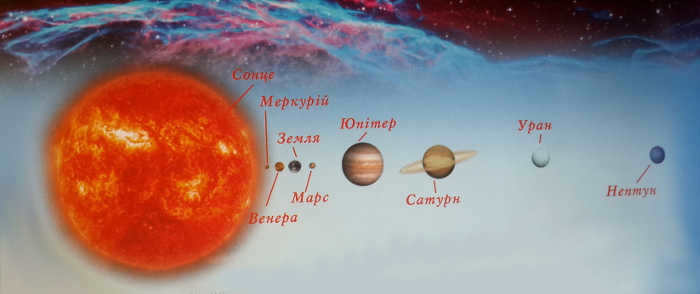
As you are aware, scientists have devised an astronomical unit to gauge the distances from the Sun to the planets and between planets. But what exactly is a light-year?
It is important to note that the light-year, despite its name’s connotation with time, is actually a unit of measurement used in astronomy to quantify distance.
What is the equivalent of a light year?
When scientists were able to calculate distances to the nearest stars, they realized that the astronomical unit was not convenient for measuring such vast distances. To give you an idea, the distance from the Sun to the nearest star, Proxima Centauri, is approximately 4.5 light-years. This means that it takes light from our Sun 4.5 years to reach Proxima Centauri! But how far is that exactly? Well, let’s not get into the nitty-gritty of calculations, but just keep in mind that light particles travel at a speed of 300,000 kilometers per second. For instance, if you were to send a signal from a flashlight to the Moon, it would be seen there in less than one and a half seconds. On the other hand, it takes about 8.5 minutes for light to travel from the Sun to the Earth. So, how many light rays travel in a year?
Let’s accept the fact: approximately 10 trillion kilometers make up a light year. (a trillion meaning twelve zeroes). More specifically, 9,460,730,472,581 kilometers. If translated into astronomical units, that would equate to about 67,000. And keep in mind, this is only referring to the closest star!
Clearly, in the realm of stars and galaxies, the astronomical unit is not a practical unit of measurement. It is much simpler to utilize light-years in calculations.
Application in the celestial realm
For instance, the distance from Earth to the most brilliant star in the sky, Sirius, measures 8 light-years. Similarly, the distance from the Sun to Polaris amounts to approximately 600 light-years. Consequently, it takes 600 years for light emitted from our planet to reach that destination. This equates to roughly 40 million astronomical units. By way of comparison, it is worth mentioning that the diameter of our galaxy, the Milky Way, spans about 100,000 light years. The Andromeda Nebula, our closest neighboring spiral galaxy, lies 2.52 million light years away from Earth. Expressing this distance in astronomical units proves to be quite inconvenient. However, there exist objects in the Universe that are located at a staggering distance of 15 billion light years from us. Thus, the radius of the observable Universe extends to 13.77 billion light years. It is important to note that the entire Universe, as we comprehend it, extends beyond the observable section.
By the way, the radius of the observable Universe is not simply twice the diameter, as you may assume. This is due to the fact that the cosmos is expanding continuously. Those celestial objects that emitted light 13.77 billion years ago have actually moved even further away from us. Currently, they are located more than 46.5 billion light years away. If we double that distance, we arrive at the true diameter of the observable Universe, which is 93 billion light-years. Consequently, the size of the observed part of the cosmos, also known as the Metagalaxy, is constantly increasing.
Trying to measure such distances in kilometers or astronomical units is nonsensical. In all honesty, even light-years are not entirely suitable. However, no better alternative has been proposed so far. The resulting numbers are so immense that only a computer can handle them.
Therefore, a light year (sv. g.) is a measurement of distance, not time, representing the distance a sunbeam travels in one year, or 365 days. This particular unit of measurement is highly advantageous due to its clarity, as it enables us to determine the time it would take for an electromagnetic message to reach a specific star. If this time period is excessively long (such as a thousand years), then such actions would be deemed pointless.






